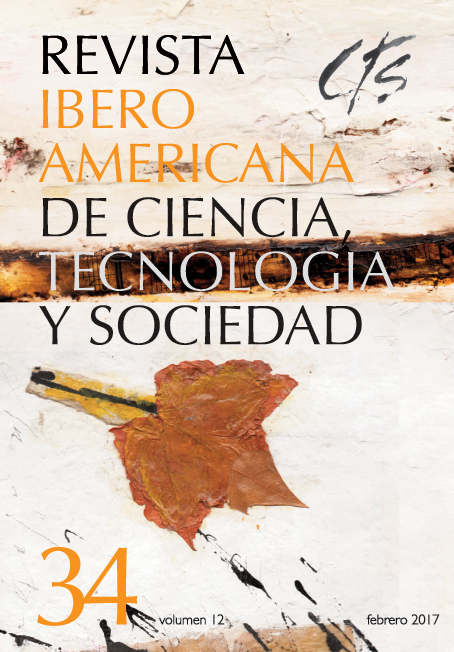Materials And Artifacts As Affordances
Keywords:
affordances, standardization, historicity, artifactsAbstract
Even if the ecology of materials relies on the concept of affordances to explain a culture without objectivizing it as a mental phenomenon, a model of cultural evolution based on affordances requires taking the structures that support the learning and technological culture processes seriously. This paper focuses on two problems related to the ecology of materials: affordances’ standardization and the history of techniques. If affordances are considered functions, and if we accept that this would mean implementing techniques and skills (for example, some sort of standardization based on the history of how it developed), then the perception of affordances will depend not only on the display of but rather the training in techniques and skills dependent on certain devices other than the materials, namely: artifacts or deliverables. The perspective of technology anthropology puts forth the processing concept of function as a mediator between materials and artifacts.Downloads
References
ALLEN, C., BEKOFF, M. y LAUDER, G. (1998): Nature´s Purposes Analyses of Function and Design in Biology, MIT Press.
BARNET, B. (2006): “Do Technical Artefacts Evolve?”, en A. Bradley y L. Armand (eds.): Technicity, Praga, Litteraria Pragensia, pp. 167-199.
BOYD, R. y RICHERSON, P. (2005): The Origin and Evolution of Cultures, Oxford University Press.
CAPONI, G. (2012): “Teleología Naturalizada: Los conceptos de función, aptitud y adaptación en la Teoría de la Selección Natural”, Theoria, n° 76, pp. 97-114.
CHEMERO, A. (2009): Radical Embodied Cognitive Science, Londres, MIT.
CHUA, L. y SALMOND, A. (2012): “Artefacts in Anthropology”, en R. Fardon, O. Harris, M. Nutall, C. Shore, T. Marchand, V. Strang y R. Wilson (eds.): The SAGE Handbook of Social Anthropology, pp. 101-114.
DERRY, T. K. y WILLIAMS, T. (2006): Historia de la Tecnología desde la antigüedad hasta 1750, Siglo XXI.
DIETLER, M. y HERBICH, I. (1998): “Habitus, Techniques, Style: An Integrated Approach to the Social Understanding of Material Culture and Boundaries”, en M. Stark (ed.): The Archaeology of Social Boundaries, Washington D.C., Smithsonian Institution Press.
GIBSON, J. (1979): The Ecological Approach to Visual Perception, Boston, Houghton Mifflin.
INGOLD, T. (2000): The Perception of the Environment Essays on livelihood, dwelling and skill, Routledge, Londres.
INGOLD, T. (2007a): “Materials against Materiality”, Archaeological Dialogues, vol. 14, n° 1, pp. 1-16.
INGOLD, T. (2007b): “The trouble with evolutionary biology”, Anthropology Today, vol. 23, n° 2, pp. 13-17.
INGOLD, T. (2011): Being Alive. Essays on Movement, Knowledge and Description, Londres, Routledge.
KNAPPETT, C. (2007): “Materials with Materiality?”, Archaeological Dialogues, vol. 14, n° 1, pp. 20-23.
LALAND, K. y BROWN, G. (2002): Sense and Nonsense. Evolutionary Perspectives on Human Behaviour, Oxford University Press.
LATOUR, B. (1996): Aramis or The Love of Technology, Harvard University Press.
LAWLER, D. (2003): “Las funciones técnicas de los artefactos y su encuentro con el constructivismo social en tecnología”, Revista Iberoamericana de Ciencia, Tecnología y Sociedad -CTS, vol. 1, n° 1, pp. 27-71.
LEMONNIER, P. (1992): Elements for an Anthropology of Technology, Anthropological Papers, Museum of Anthropology, n° 88, University of Michigan.
LEROI-GOURHAN, A. (1971): El gesto y la palabra, Universidad de Venezuela.
MAYR, E. (1961): “Cause and Effect in Biology”, Science, New Series, vol. 134, n° 3489, pp. 1501-1506.
MCLAUGHLIN, P. (2001): What Function Explain Functional Explanation and Self- Reproducing System, Cambridge University Press.
MILLER, D. (2005): Materiality, Durham, Duke University Press.
SOBER, E. (1992): “Models of Cultural Evolution”, en P. Griffiths (1992): Trees of Life. Essays in Philosophy of Biology, Dordretch, Kluwer Academic Publishers.
TILLEY, C. (2007): “Materiality in Materials”, Archaeological Dialogues, vol. 14, n° 1, pp.16-20.
Downloads
Published
How to Cite
Issue
Section
License
All CTS's issues and academic articles are under a CC-BY license.
Since 2007, CTS has provided open and free access to all its contents, including the complete archive of its quarterly edition and the different products presented in its electronic platform. This decision is based on the belief that offering free access to published materials helps to build a greater and better exchange of knowledge.
In turn, for the quarterly edition, CTS allows institutional and thematic repositories, as well as personal web pages, to self-archive articles in their post-print or editorial version, immediately after the publication of the final version of each issue and under the condition that a link to the original source will be incorporated into the self-archive.











